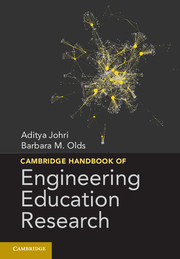Book contents
- Frontmatter
- Dedication
- Contents
- Editors
- Contributors
- Foreword
- Acknowledgments
- Introduction
- Chapter 1 Chronological and Ontological Development of Engineering Education as a Field of Scientific Inquiry
- Part 1 Engineering Thinking and Knowing
- Chapter 2 Learning Theories for Engineering Education Practice
- Chapter 3 Situative Frameworks for Engineering Learning Research
- Chapter 4 The Social Nature of Representational Engineering Knowledge
- Chapter 5 Conceptual Change and Misconceptions in Engineering Education
- Chapter 6 Engineers as Problem Solvers
- Chapter 7 Professional Engineering Work
- Part 2 Engineering Learning Mechanisms and Approaches
- Part 3 Pathways into Diversity and Inclusiveness
- Part 4 Engineering Education and Institutional Practices
- Part 5 Research Methods and Assessment
- Part 6 Cross-Cutting Issues and Perspectives
- Index
- References
Chapter 6 - Engineers as Problem Solvers
Published online by Cambridge University Press: 05 February 2015
- Frontmatter
- Dedication
- Contents
- Editors
- Contributors
- Foreword
- Acknowledgments
- Introduction
- Chapter 1 Chronological and Ontological Development of Engineering Education as a Field of Scientific Inquiry
- Part 1 Engineering Thinking and Knowing
- Chapter 2 Learning Theories for Engineering Education Practice
- Chapter 3 Situative Frameworks for Engineering Learning Research
- Chapter 4 The Social Nature of Representational Engineering Knowledge
- Chapter 5 Conceptual Change and Misconceptions in Engineering Education
- Chapter 6 Engineers as Problem Solvers
- Chapter 7 Professional Engineering Work
- Part 2 Engineering Learning Mechanisms and Approaches
- Part 3 Pathways into Diversity and Inclusiveness
- Part 4 Engineering Education and Institutional Practices
- Part 5 Research Methods and Assessment
- Part 6 Cross-Cutting Issues and Perspectives
- Index
- References
Summary
Engineers as Problem Solvers
Evers, Rush, and Berdrow (1998) identi-fy numerous disconnects between skills acquired in college and those required of the workplace. Among the most important skills that ABET Inc., the primary engineering accreditation institution in the United States, has identified for the preparation of engineers are the abilities to identify, formulate, and solve workplace engineering problems and to function on multidisciplinary teams. Learning to solve workplace problems is an essential learning outcome for any engineering graduate. Every engineer is hired, retained, and rewarded for his or her ability to solve problems. However, engineering graduates are ill prepared to solve complex, workplace problems (Jonassen, Strobel, & Lee, 2006).
Problem solving from a cognitive perspective has been the primary focus of my research for the past decade and a half. My theory differs from traditional theories of problem solving in that I argue there are different kinds of problems that vary between contexts. The kinds of problems that practicing engineers solve are different from the problems that most undergraduate science, technology, engineering, and mathematics (STEM) students learn to solve. In most undergraduate classes, students learn to solve textbook problems that are constrained and well structured, with known solution paths and convergent answers (capstone courses are an exception). Workplace problems, on the other hand, tend to be ill structured and unpredictable because they possess conflicting goals, multiple solution methods, non-engineering success standards, non-engineering constraints, unanticipated problems, distributed knowledge, and collaborative activity systems (Jonassen et al., 2006). Learning to solve classroom problems does not effectively prepare engineering graduates to solve workplace problems. To prepare engineering graduates, it is necessary to articulate the differences between educational problems and workplace problems. To do that, I first describe how problems vary.
- Type
- Chapter
- Information
- Cambridge Handbook of Engineering Education Research , pp. 103 - 118Publisher: Cambridge University PressPrint publication year: 2014
References
- 58
- Cited by

